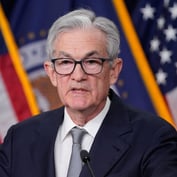Market volatility is likely going to continue to be high for the next two quarters, according to Ben Inker, a partner at Grantham, Mayo, Van Otterloo & Co. — the investment management firm co-founded by Jeremy Grantham.
However, though the possibility of a recession has increased in 2022, any potential recession is “more likely than not to be fairly shallow,” says Inker, the head of GMO’s asset allocation team.
“In fact,” he says, “if a recession were enough to kill the inflation problem, it would probably be a better outcome for investors than continued economic growth accompanied by continued inflation.”
Via email, we asked Inker a few questions about the state of the current market and where he thinks it’s headed.
1. What’s your view on where volatility is headed in Q3 & Q4 and why?
Ben Inker: We don’t generally try to forecast markets over periods as short as a quarter or two but it does seem likely that volatility will remain high over the next couple of quarters given the highly unusual backdrop for the markets at the moment.
Equity investors seem to prize stability and predictability over anything else, and this goes some way to explaining why this year has been so tough for equities.
In the late 1990s Jeremy Grantham and I put together an “Investor Comfort” model to explain valuations in the U.S. equity market. It used three factors — volatility of GDP growth, deviation of inflation from 2.5% and corporate profitability — to explain the ebb and flow of valuations of the U.S. stock market.
Investors demonstrated a preference for economic stability over strong growth, preferring an economy with stable low growth and stable inflation over rapid growth accompanied by volatile prices. The model did an excellent job of explaining the valuations of U.S. stocks from 1925-1998 and has also done a good job explaining the market since then.
While the model “missed” the internet bubble, it did predict that the market in the late 1990s should have been more expensive than at any time before. It was again predicting record high P/Es as recently as last year. But, as inflation has soared, the predicted valuation of the market has come down rapidly.
Over the next couple of quarters, the economic data will be particularly important. If inflation were to come down rapidly that source of investor discomfort would fall away. But if inflation is falling because of an economic slowdown that reduces corporate profits, the one strong support for the market at the moment — record high corporate profits — might well collapse at the same time.
If the economy seems to be walking the tightrope of “soft landing,” you could easily imagine a sharp relief rally as inflation recedes as a threat to stability. But any data that shows either continued inflationary pressures or softening corporate profitability could easily cause the market to fall materially.
It seems likely that the market will actually exhibit both upside and downside volatility as various pieces of data point to one outcome or the other.
2. What are the greatest risks and opportunities for investors in this environment and why?
The greatest risk to investors is that inflation proves persistent enough that the interest rate pattern of the last 20 years proves untenable.
Were interest rates to have to move to where economists used to think was the natural level — real short rates of somewhere near productivity growth — the valuations of both equities and bonds will have to fall sharply, since neither is priced for a world where the fed funds rate will average 3-4% over the next couple of decades.
This is particularly true for U.S. equities since they trade at much higher valuations than stocks in the rest of the world.
Inflation is generally the worst event that can happen to investors’ portfolios since there are no assets which reliably do well in high inflation.
But there are some assets today that are already priced at levels which are consistent with higher interest rates, and these assets offer the nice combination of potential resilience in the event of inflation and upside if inflation risks recede.
Japanese and emerging equities are priced at levels where they deserve to do fine even in an inflationary outcome, and if they were to fall along with more expensive assets if inflation remains a problem, they would at least have the compensating benefit of offering very compelling dividend and earnings yields at their quite low resulting valuations.









 June 30, 2022 at 11:21 AM
June 30, 2022 at 11:21 AM











